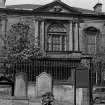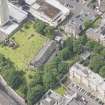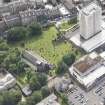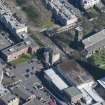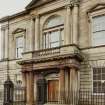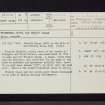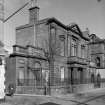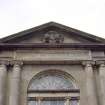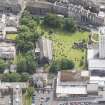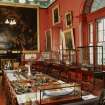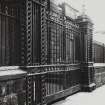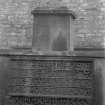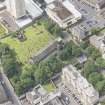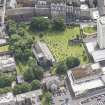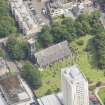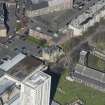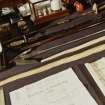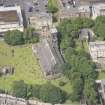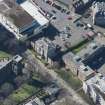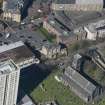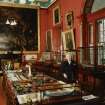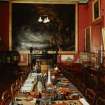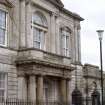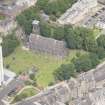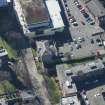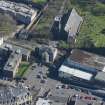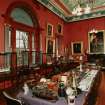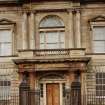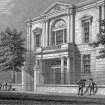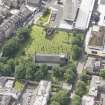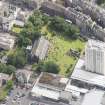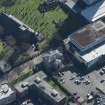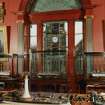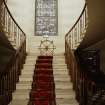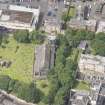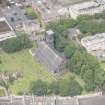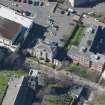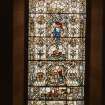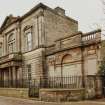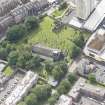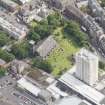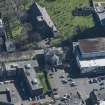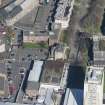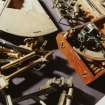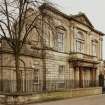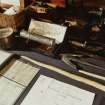Following the launch of trove.scot in February 2025 we are now planning the retiral of some of our webservices. Canmore will be switched off on 24th June 2025. Information about the closure can be found on the HES website: Retiral of HES web services | Historic Environment Scotland
Edinburgh, Leith, 99 Kirkgate, Trinity House
Hospital (16th Century), House (19th Century), War Memorial (20th Century)
Site Name Edinburgh, Leith, 99 Kirkgate, Trinity House
Classification Hospital (16th Century), House (19th Century), War Memorial (20th Century)
Alternative Name(s) Mariner's Hospital; War Memorial; Scottish Seafarers War Memorial Window
Canmore ID 51947
Site Number NT27NE 31
NGR NT 26991 76086
Datum OSGB36 - NGR
Permalink http://canmore.org.uk/site/51947
- Council Edinburgh, City Of
- Parish Edinburgh (Edinburgh, City Of)
- Former Region Lothian
- Former District City Of Edinburgh
- Former County Midlothian
NT27NE 31 26991 76086
(NT 2699 7608) Trinity House (NAT) on the Site of Old Trinity House (NR) (1555)
OS 6" map, Edinburghshire, 1st ed., (1853)
Trinity Hospital, which stood at the corner of Kirkgate and Giles Street, was demolished in 1816 to make way for Trinity House. A panel, taken from the old building, and inscribed "In the name of the Lord ve masteris and mareneris by1(d)is this hovs to ye povr Anno Domini 1555", is built into the side wall. This is the oldest inscribed stone in Leith.
Name Book 1852; RCAHMS 1951.
Trinity House and the dated panel remain unchanged in an area of modern housing development.
Visited by OS (B S) 27 November 1975.
NT 269 760 An excavation was undertaken in the vaulted basement of Trinity House (NT27NE 31) prior to the re-laying of the floor. The basement comprises three E-W aligned vaults. The area is accessed via a short flight of stone steps from the courtyard into a short passage. This leads to a doorway in the SW corner of the basement area, opening into a N-S aligned corridor along the W side of the S and central vaults and leading to the N vault. The general aim of the excavation was to remove approximately 100mm of the upper deposits from the whole of the floor area.
The results are described in terms of three basic periods of construction and occupation:
Period 1: The original vault construction and occupation 1555 to c 1816. The vaults generally date from this period and all the main walls were built at this time. The present access and the layout of the vaults is generally unchanged from Period 1, but the present steps are probably a revision of an earlier series.
Period 2: Refurbishment of the cellars, c 1816 to late 20th century. This period saw the separation of each vault space into the present 'room' configuration, as a series of interconnected chambers. They were in turn separated from each other with gates or doors between. The vaults were ultimately furnished with 'wine cellar' style brick and concrete storage boxes or bins.
Period 3: Late changes/conversions, late 20th century to present. The doors between rooms were removed at this time and the cellar reverted to a generally open area, ultimately used as a coal store.
Archive to be deposited in the NMRS.
Sponsor: HS
G Ewart and A Radley 2002
NT27NE 31 26991 76086
Architect: Thomas Brown, 1816.
NMRS REFERENCE:
Plans:
Dick Peddie & MacKay, Edinburgh Additions to stables and gate-lodge.
Bin 13, Bag 3 Peddie and Kinnear 1865
EXTERNAL REFERENCE:
Sources: Dean of Guild.
Petitioner: Petition of the Master & Assistants of the Trinity House, Leith Works: Rebuilding of chimney Date: 10 June 1813 New ECA location: Box 116 – June-July 1813
Petitioner: Petition for John Hay & Others Works: Building of new Trinity House Date: 10 May 1816 New ECA location: Box 122 – April-June 1816
Publication Account (1951)
239. Carved Stones, Trinity House, Kirkgate.
Trinity Hospital, which stood at the corner of the Kirkgate and Giles Street, was demolished in 1816 to make way for Trinity House. In the modern building the following details have been inserted for preservation.
(1) A panel built into the side wall, inscribed INTHE NAME OF THE / LORD VE MASTERIS / AND MARENERISBYL(D)IS / THIS HOVS TO YE POVR / ANNO DOMINI 1555.This is the oldest inscribed stone in Leith.
(2) A 17th-century door-pediment, built into the N.W. wall, bears the inscription PERVIA VIRTVTI SYDERA TERRA MARE ("Courage makes its way through heaven, earth and sea"), accompanied by representations of the navigating instruments of the time, together with an anchor and two globes.
(3) A second pediment, obviously recut and probably to be referred to the 17th century although bearing the date 1570, is inserted above the entrance to the courtyard from Giles Street. It displays a heart charged with an anchor. Another stone immediately below it bears the following quotation from the Psalms: THEY THAT GOE DOWN TO THESEA IN SHIPPES, THAT DOE BUSINESS IN THE GREAT WATERS, THESE SEE THE WORKS OF THE LORD AND HIS WONDERS IN THE DEEP. PSALM 107, VERSES 23 AND 24.
RCAHMS 1951, visited c.1941
Project (1997)
The Public Monuments and Sculpture Association (http://www.pmsa.org.uk/) set up a National Recording Project in 1997 with the aim of making a survey of public monuments and sculpture in Britain ranging from medieval monuments to the most contemporary works. Information from the Edinburgh project was added to the RCAHMS database in October 2010 and again in 2012.
The PMSA (Public Monuments and Sculpture Association) Edinburgh Sculpture Project has been supported by Eastern Photocolour, Edinburgh College of Art, the Edinburgh World Heritage Trust, Historic Scotland, the Hope Scott Trust, The Old Edinburgh Club, the Pilgrim Trust, the RCAHMS, and the Scottish Archive Network.
Field Visit (24 April 2002)
Above the gate to the courtyard of Trinity House (Kirkgate), is a stone with a steep pediment carved in relief with a fouled anchor and the above inscription.
The stone is a fragment from the hospital built by the Fraternity of Masters and Mariners of Leith in 1555.
Inspected By : I. C. Grant
Inscriptions : Above inscription panel: 1570
On panel above anchor: They that goe down to the sea in shippes / That doe business in the great Waters / These see the works of the Lord / And his wonders in the deep / (Psalm 107 Verses 23 and 24)
Signatures : None
Design period : 1570. Inscription recut in 1883
Information from Public Monuments and Sculpture Association (PMSA Work Ref : EDIN1030)
Field Visit (24 April 2002)
Coat of arms of the mariners of Trinity House, comprising two globes, an anchor, a cross-staff and other nautical instruments in use in the 16th century.
The foundation stone of the new Trinity House was laid on 4 June 1816. By September the coat of arms was in the pedestal. The motto, however, had been altered by the sculptor to 'Per, Via, Virtuti, Sidere, Terra, Mare', rather than 'Pervia, Virtuti, Sydera, Terra, Mare' which had been on the coat of arms on the old building for over 270 years. Professor Alexander Christison, Professor of Humanity at Edinburgh University, was consulted. His opinion was that the alteration was "very corrupt vicious and nonsensical" and the "production of some sheer ignoramus". The motto on the former building was "truly grammatically correct and appropriate" and "a beautiful hexameter verse taken from some of the classic Poets (Ovid)". Literally it could be translated as "Stars Land Sea (are) pervious to Virtue", a free translation being "Virtue Masters Astronomy Geography Navigation". The sculptor was "ordered to correct and conform rigidly to the words on the old Arms". The new coat of arms cost £10 15/-. (1)
Inscriptions : On ribbon curving over globes (incised letters):
PERVIA VIRTUTI SYDERA TERRA MARE
Signatures : None Visible
Design period : 1816-1818
Information from Public Monuments and Sculpture Association (PMSA Work Ref : EDIN1459)
Excavation (8 February 2002 - 19 March 2002)
NT 269 760 An excavation was undertaken in the vaulted basement of Trinity House (NT27NE 31) prior to the re-laying of the floor. The basement comprises three E-W aligned vaults. The area is accessed via a short flight of stone steps from the courtyard into a short passage. This leads to a doorway in the SW corner of the basement area, opening into a N-S aligned corridor along the W side of the S and central vaults and leading to the N vault. The general aim of the excavation was to remove approximately 100mm of the upper deposits from the whole of the floor area.
The results are described in terms of three basic periods of construction and occupation:
Period 1: The original vault construction and occupation 1555 to c 1816. The vaults generally date from this period and all the main walls were built at this time. The present access and the layout of the vaults is generally unchanged from Period 1, but the present steps are probably a revision of an earlier series.
Period 2: Refurbishment of the cellars, c 1816 to late 20th century. This period saw the separation of each vault space into the present 'room' configuration, as a series of interconnected chambers. They were in turn separated from each other with gates or doors between. The vaults were ultimately furnished with 'wine cellar' style brick and concrete storage boxes or bins.
Period 3: Late changes/conversions, late 20th century to present. The doors between rooms were removed at this time and the cellar reverted to a generally open area, ultimately used as a coal store.
G Ewart and A Radley 2002
Sponsor: Historic Scotland
Kirkdale Archaeology
Excavation (17 December 2007 - 20 March 2008)
NT 2699 7608 A programme of work was undertaken 17 December 2007–20 March 2008. Limited excavation in the N range revealed a complicated range of features. Many of these could not be physically related to each other. Despite this, a greater understanding has been gained of the most recent structure on this site, in particular its floor levels and internal divisions, which were built in two phases. Hints of earlier archaeological deposits were also noted. It is possible that another cellar or a large cut for the existing cellar could exist under the N range. The location directly opposite S Leith parish church, suggests that this area may have been an early focus for settlement.
During the standing building survey various features which pre-date the 1816–18 rebuild were identified. These include a possible 16th-century vault and a possible staircase or N/S wall built into the N wall. The whole of the E elevation and the E half of the S elevation definitely date to the 1816–18 build. The W half of the S elevation probably relates to this build, but could be a later insertion. Evidence for the 1816–18 roof only survives on the E wall and the E half of the S wall. It is likely that following the removal of the roof in the 20th century, the N wall, W wall and the W half of the S wall were reduced to a uniform height, repaired with bricks and rebuilt to create a flat course for coping slabs.
Archive: RCAHMS (intended)
Funder: Historic Scotland
Information from Sarah Hogg and David Murray (Kirkdale Archaeology) 28 March 2008.
OASIS ID: kirkdale1-60022

















































































